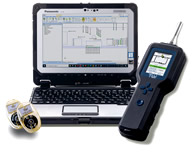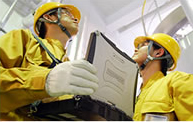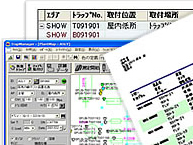Steam Trap Surveys
Did you know, in an average steam-using plant, 23.8% of steam traps are either leaking significant amounts of steam or blocking condensate drainage*?
These failed traps cause considerable amounts of wasted energy and prevent steam processes from running efficiently.
TLV's vast experience of steam trap surveys and extensive knowledge of steam traps and equipment enables us to constantly pursue ways to improve the accuracy of diagnosis, to provide objective and quantitative output, and to enable our clients to continuously manage their steam traps and achieve energy savings.
Our steam trap surveys are not merely a substitute for in-house inspection work, but a professional service that generates value for your business.
* Based on benchmark data from surveying over 350,000 steam traps.
Losses and CO2 reductions that can be determined by diagnosis
Steam leakage from steam traps and bypass valves can be quantified and converted into monetary values to accurately grasp the effect.
In particular, steam loss represents a significant amount of money when viewed on a plant-wide basis.
To help site users achieve peace of mind, surveys are specifically designed to provide reliable data which can be used to perform budget allocations and analyze return on investment. These methods can be a key resource for sites to precisely estimate financial gains and establish a concrete plan to reduce failures.
Advantages of Using an External Survey Provider
"Eliminating such a large number of defective steam traps will allow us to save energy."
We hear this from many steam users, who also find that it is more difficult than expected to put this into practice. When asked what problems and issues they had before requesting a steam trap survey, our users had this to say:
- "There are too many traps to manage effectively"
- "Conventional trap testing methods are unreliable"
- "We have a rough understanding of the site situation, but have not taken measures to rectify problems"
- "Difficult to judge the effect of trap surveys on energy savings"
Similar reasons are often given for not implementing trap management strategies.
Analyzing the failure rate of a sample of approximately 170,000 traps surveyed in Japan on a site-wide basis, the failure rate was 25.0% at the time of the first survey, but fell to 9.4% in the fourth year after implementing TLV's trap management program on a regular basis.
If you view our consulting services as not just inspections, but also as a consulting service that includes the steam trap area, then outsourcing may be an option for you.
Surveys by professionals using the latest technology
Trap diagnostic equipment with excellent judgment accuracy
Our surveys utilize the latest TrapMan® diagnostic equipment specially developed by TLV.
The equipment can be used for non-TLV products, and it automatically determines the operation and quantifies the amount of steam leakage. Its reliability has been evaluated by an internationally recognized third-party certification organization.

Assessing the current state with reliable diagnostic technology
Surveys are performed by TLV-trained and accredited professional personnel.
The amount of steam leakage is converted into a monetary value and losses are clearly indicated. Recommended models are selected for the parts that need to be replaced.
As a general rule, the failure rate, defective parts, and amount of loss are reported on the day the diagnosis is completed.

Continuous management system
Creating a plant map and collecting data
We collect data covering up to 64 items, including steam traps, peripheral valves, piping, operating conditions, etc. We determine the year of installation (= service period) from the serial number, lot number, etc., as well as the manufacturer and model of the trap.
We then prepare and submit a trap survey list and layout drawing based on the information collected .

Diagnosis of bypass valves
In addition to the operational status of the trap itself, TLV's surveys also check for leakage of the bypass valves, the open/closed status of the upstream valve, and the operational status of the equipment ahead of the trap to estimate and quantify the total amount of internal leakage.
Follow-up on defective parts
We will follow up on defective areas at a later date with recommended products and installation methods.
Diagnostic Steps
Step 1
Meeting
- Outlining the survey process
- Preliminary coordination
- Discussion of details
Step 2
On-site survey
- Data collection
- Trap and bypass valve survey
- Investigation of trapping problems
- Investigation of surrounding valves, etc.
Failure locations only
- Recommended product selection
- Identifying the ideal replacement method
Step 3
Report on completion date
- Report
- Layout drawing
- Trap list details
Step 4
Proposal
Recommendations for
- Product replacements
- Replacement methods